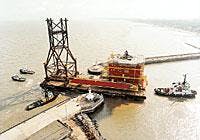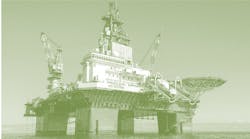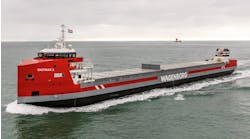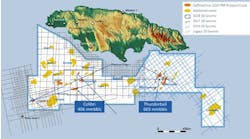Marathon tackles UK gas shortage
Britain's imminent gas supply shortfall could necessitate four new long distance trunklines from Norway over the next five years. So indicated Bill Hastings, Managing Director of Marathon Inter-national Petroleum, in Oslo last month.
The first of these lines will likely be the Marathon-driven Symphony Pipeline System, which will take gas from Heimdal and Brae, on either side of the median line in the Central North Sea, directly to the Bacton gas reception terminal on the southeast English coast.
Unless new gas provinces closer to home are brought on stream, Britain faces a gas deficit from 2006 equivalent to 75 tcf over 25 years, Hastings said. Most of the demand growth will come from southern England. Today, however, incoming supplies from the central and northern North Sea are directed largely to St. Fergus, north of Aberdeen.
This transport pattern has led to congestion in the associated trunkline networks, including Brae's, operated by Marathon. Over the past two years, Hastings added, individual producers have racked up more in entry capacity charges to St. Fergus than the projected cost of Symphony alone ($900 million at today's steel prices).
Heimdal overhaul
Norsk Hydro's Heimdal complex underwent an overhaul recently, including a new riser platform and the installation of the Vesterled line linking gas fields in this area with the Frigg system, which also terminates at St. Fergus. Symphony gives scope for development of further small finds in the Heimdal area. Marathon itself has purchased various interests just to the west in Norwegian waters, which it aims to develop using Heimdal's infrastructure. The first of these will likely be Kameleon.
Heimdal would be connected to Brae via a proposed Symphony link line. Although there are treatment facilities at Heimdal, another platform could be installed there to strip out natural gas liquids from gas entering the Symphony system, coincident with growing demand from the UK.
Dried gas would then feed through the rest of the system to Bacton, via Brae. Over time, Hastings sees scope for supplies also from Norsk Hydro's giant Ormen Lange Field off mid-Norway, which could be routed to Heimdal via the Sleipner facilities just to the north. Symphony could also stimulate development of further third-party fields within reach of Brae, Statoil's Gudrun being currently the strongest candidate.
The main purpose of the announcement in Oslo was to launch an "open season" for discussions with interested parties at all levels. The targeted closure date for this process is Oct. 15. By then, Marathon aims to have in place a series of commitments from shippers and purchasers, as well as a clearer idea of the scope of construction work involved.
Ideally, installation of the lines should get under way by 2004, leading to first gas deliveries by end-2005. Planned capacity of the main 36-in., trunkline is 900 MMcf/d. Marathon anticipates being 40% operator.
"We could fund the whole of the line if need be," Hastings said, "but the rules in Norway prevent us from having complete ownership." The company also aims to introduce greater flexibility for tariff and marketing arrangements than currently exist in the UK sector. Co-owners need not necessarily be field producers.
Sell-off favors old guard
Norway's latest auction of upstream assets held by the State Direct Financial Interest (SDFI) raised NKr8.4 billion, according to the Petroleum and Energy Mini-stry. That sum may be NKr1 billion below their true worth, say analysts Wood Mackenzie in a new report. The sell-off is part of a restructuring exercise that includes the partial privatization of Statoil and the creation of a new company, Petoro, to manage remaining state-owned interests.
Other secondary aims include maximizing value for the state by strengthening the hand of some existing foreign operators and bringing in new players. Theoretically, this effort should in turn drive more marginal or satellite field dev-elopments.
As Wood Mackenzie points out, however, the main beneficiary from the latest sales appears to be Norsk Hydro, one of Norway's big two, which now has extra production of 45,000 BOE/d. Most of this relates to larger percentages in Hydro's core Grane and Oseberg area assets. Statoil was excluded from this latest bidding round.
Eight other applicants were successful. Among these were Shell, which has built on its position in Draugen, making incremental projects there more realistic. Denmark's DONG gained ground in the Gyda/Tambar areas, while Gaz de France and Idemitsu picked up stakes for the first time in Fram. Most of the assets offered were in the Northern North Sea, predominantly oil, and largely high quality. But the overall impact of these trades may prove to be minimal, the analysts claim, causing certain waverers disillusioned with Norway to question their commitment to the sector.
Non commercial outcome for Tott
Statoil is considering a pooled development of several reservoirs close to Norne off mid-Norway, following a discovery in the Staer structure. The well, drilled over four months by the semi Stena Don, found oil in the Jurassic, of similar quality to Norne's crude 3 km to the southwest.
Statoil drilled a 600-m sidetrack to clarify Staer's extent. It appears to be smaller than Svale and Falk, two other untapped commercial finds to the northeast. These also are within tieback reach of the Norne FPSO. Statoil now plans a further well with the same rig on the Blaameis structure east of Norne.
Shell's Tott discovery in the Norwegian Sea was a virtual washout, with more water than hydrocarbons. Gas condensate was tracked at the top of the reservoir, but not enough at this stage for s standalone development. Hopes had been high of finding a super-giant gas field to rival Ormen Lange. BP suffered a similar disappointment recently with its Havsule wildcat. Shell may persevere with further wells on other nearby prospects, however, as this area is viewed as a future supply hub for European gas sales contracts.
Agip takes stock of Faeroese models
Drilling off the Faeroe Islands has stalled, following the initial burst of activity late last summer. The sole well planned for this season, by Agip in License 002, has now been deferred with the permission of the Faeroese Petroleum Ministry.
Although one of last year's wells, Amerada's Marjun, led to a discovery, the results in general did not match seismic interpretations or geological models. The ministry therefore accepted the need for a further period of analysis, although Agip will be obliged to drill by July 2003.
In the more temperate waters of the southern Mediterranean, Eni has spudded the first exploratory well for many years offshore Malta, testing a structure on the southern flank of Italy's Ragusa Basin.
Nearby in the Sicily Channel, Eni has notched a gas discovery with a well on the Panda prospect, 20 km off southern Sicily in 460 m of water. The well flowed at 19 MMcf/d on test from two intervals. Initial reserve estimates are 300-400 bcf.




